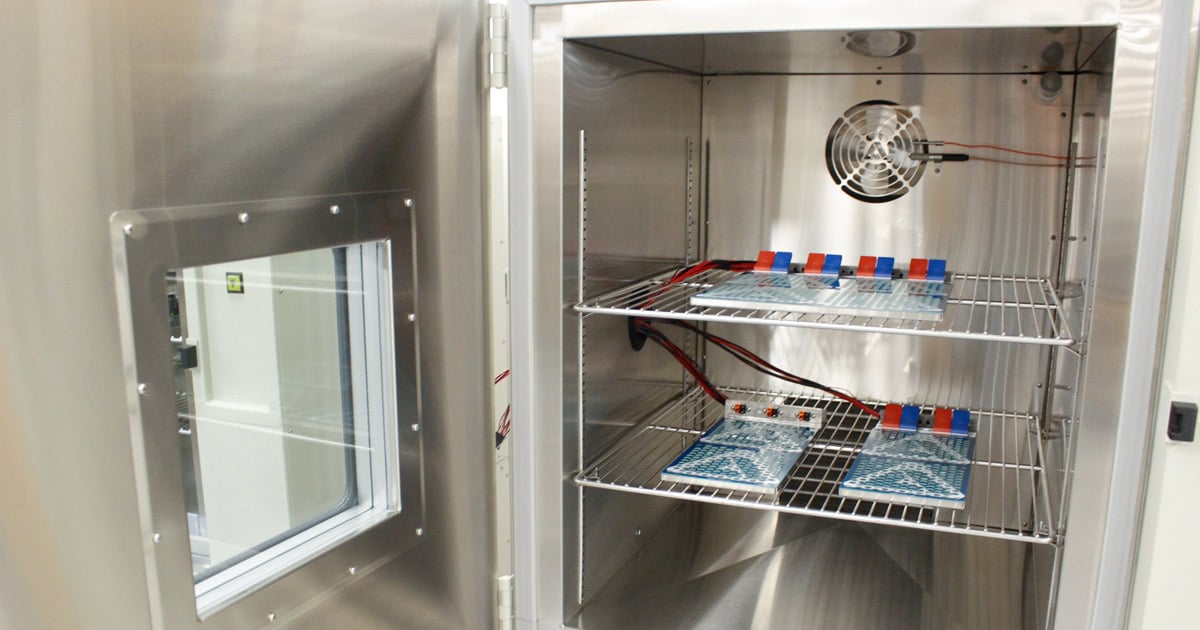7 Frequently Asked Questions on Battery Test Chambers

What are your battery test chamber needs? We guarantee they’re just a bit different from a neighboring company. Each industry, from EVs to consumer electronics, has specific requirements, equipment, and lab space that determine its testing needs. However, while there are stark differences from company to company, there are always shared goals. Every customer who comes to Associated Environmental Systems (AES) wants their tests to run efficiently, effectively, and safely. Thankfully, you’re in good hands. At AES, we’ll provide you with the best chamber or battery testing fixture solution and readily available answers to frequently asked questions. Learn more today!
1. What is a Battery Test Chamber?
Understanding a battery’s capabilities is essential to bring a product to market. That’s where battery testing comes in. Created in a range of styles and sizes, battery test chambers simulate intense real-world conditions that are likely to occur, from extreme temperatures to humidity. By charging and discharging them in a controlled environment, you can fully assess a battery’s effectiveness and reliability.
2. What is a Battery Testing Fixture?
Revolutionary and forward-minded, AES offers one-of-a-kind battery testing fixtures. The ATP® (All Test Platform) series includes four types of fixtures which include:
- ATPPRIME (patented)
- ATPHEAVY (patent-pending)
Integrated within the chamber, customers can leverage these fixtures to accommodate a variety of cell formats, sizes, channel counts, and amperage requirements up to 1,200 amps and as low as one to five amps. We consult you on your testing needs, and if you know you have future battery testing plans or your requirements could potentially change, we can accommodate those requests within our ATP platform without having to purchase new chambers or fixtures. Our ATPs provide a lifetime value, saving customers financially in the long run.
3. Before Contacting Your Test Chamber Manufacturer, Do You Have to Establish All Your Testing Needs?
Lithium-ion battery technology has grown at an exponential rate over the past years. As new chemistries are discovered and leveraged, numerous industries find themselves struggling to keep up with requirement shifts and are left with outdated chambers and fixtures. With AES’s ATPHEAVY Adaptable, customers can rest assured that their chamber can evolve with their testing needs. With the Adaptable’s interchangeable system, customers can easily switch a type of cell format and size to align with future requirements. Our perforated surface allows connections to be repositioned as cell sizes change as well as maintain proper airflow throughout the chamber. So as battery technology continues to transform, you can feel prepared for the next generation.
Meet the ATP Adaptable
4. How Many Battery Cells Can I Test at One Time?
This question relies heavily on your chosen cycler. The cycler will give you a specific current rating and a predetermined channel count. Depending on your shelf size, which is determined by the chamber volume, AES will then tailor a solution based on testing needs. Committed to lean design, our team will recommend double or even triple-stacking chambers to incorporate multiple fixtures across multiple chambers to maintain safety, reduce footprint, and lower propagation risk. It is safer to limit channels by current, especially when testing higher current cells. Benchtop chambers allow cells to be tested in a more controlled environment that can be better managed by safety features built into the chamber.
5. What is the Importance of Battery Safety Features?
AES takes battery safety seriously. We created AES SAFE for our line of battery test chambers, built on EUCAR hazard levels. Each chamber has the required safety to first prevent and then mitigate circumstances that could lead to a battery thermal event (BTE). Some safety features include:
- High/Low Temperature Limit
- Rapid Temperature Change
- Burst Disk/Low Flow Vent
- Chamber Alarm Output
- Safety Purge
Have full confidence in AES’s advanced battery testing safety features. Test confidently, knowing you can trust your chamber to test safely in your lab space.
6. What if I already Have a Battery Cycler?
It’s recommended to select your cycler before reaching out to your chamber manufacturer. The cycler determines the current rating, which lets our team plan out how many shelves and channels are needed per shelf. If you happen to be already working with us—don’t worry—we have relationships with all cycler manufacturers. We’ll work with you to find the best option.
7. Will I Be Able to Monitor the Battery Test Remotely?
AESONE CONNECT software allows customers at AES to monitor and configure battery tests from anywhere they have internet access. Standard on all AES battery testing chambers, the software can even be retrofitted on existing chambers. With AESONE CONNECT, you’ll have access to monitor tests remotely, build profiles and start, pause, and stop testing at the touch of your desktop, laptop, or tablet. While sitting at a cafe or in a board meeting, you can closely monitor as real-time data collection comes throughout testing. As soon as an error is detected, you will be alerted and have the option to stop the test.
Let’s Get Started
As you prepare to buy your first or fifth battery test chamber, we know first-hand how important it is to feel heard and understood. That’s why we invite you to read through our Battery Chambers Buyers Guide and talk to an AES sales engineer to get started. We’ll be more than happy to listen to your questions and walk through recommendations. Let’s find the best battery testing solution for your company today.
Should you have more questions about battery testing, contact us today.



